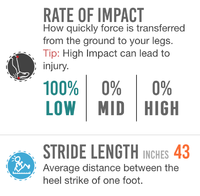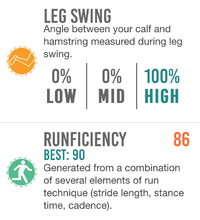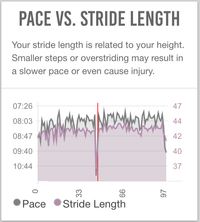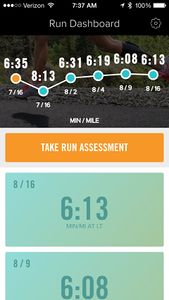Difference between revisions of "Running Sensors"
User:Fellrnr (User talk:Fellrnr | contribs) (Created page with "There are a growing number of wearable devices that will analyze your biomechanics, mostly from small startup companies, though the bigger players are also contributing to the...") |
(No difference)
|
Revision as of 12:08, 4 July 2016
There are a growing number of wearable devices that will analyze your biomechanics, mostly from small startup companies, though the bigger players are also contributing to the space. Many of these devices a making use of the cheap and accurate accelerometers that are now readily available, though there are some other approaches being used.
Contents
[hide]1 Garmin's Running Dynamics
Many newer Garmin watches ( 620, 920XT, Epix, Fenix 3, etc.) combined with a special chest strap will provide extra metrics that can give insight into your Running Form. The Garmin watches will provide these metrics in real time, allowing you to see the effect of changes in your form. These metrics include:
- Vertical Oscillation. This is how much the torso moves up and down with each stride. It is generally believed that less Vertical Oscillation is a better, but I suspect that this is an oversimplification. It's sometimes a thought that a greater vertical oscillation will result in greater impact, but this is not the case. Impact is how quickly you decelerate, so landing hard can result in less vertical movement but a shorter, more intense deceleration. It's even suggested that greater vertical oscillation will result in more braking force, but that does not seem reasonable. I believe that some are part of a runners vertical movement is likely to be elastic in nature (consider a bouncing rubber ball), some of the vertical motion will be while the runner is airborne (ballistic), and some of the vertical motion is the vertical deceleration as the runner lands. So it seems likely to me that excessive vertical oscillation is bad, but it's a tricky to know what excessive is likely to be, or how to correct it.
- Ground Contact Time (GCT). The Science of Running Economy generally shows that longer Ground Contact Time is correlated with poorer Running Economy.
- Ground Contact Time Balance. This is the relative Ground Contact Time ratio of the left and right feet, which will reveal potential imbalances in the body.
- Computed metrics. The Garmin watches will use the basic metrics to calculate things like stride length (based on cadence and pace), and Vertical Ratio (vertical oscillation to stride length ratio).
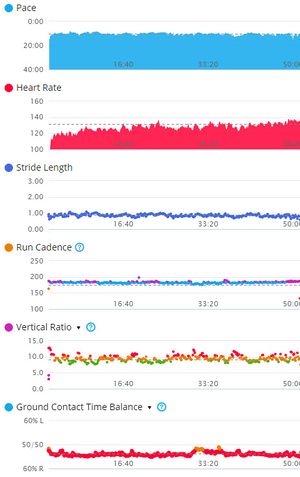
2 RunScribe
RunScribe is a small pair of Footpod's that provide a wide variety of Foot Strike metrics. These include things like Impact G's, GCT, Braking G's, Pronation, and more. I love the detailed metrics that are provided, and the insight into my running form, and possible imbalances. The main disadvantage with the RunScribe approach is that the data is not available during the run, and has to be analyzed afterward. You can read about my testing at RunScribe.
3 MilestonePod
MilestonePod is a vastly cheaper alternative to RunScribe, and while it doesn't provide the detailed analytics, it's a great value for money. It's also a cheap and effective way of keeping track of the mileage of your shoes, and is worth its price for that feature alone. Like RunScribe the MilestonePod doesn't provide real-time metrics, and you have to analyze the results post run. You can read about my testing at MilestonePod.
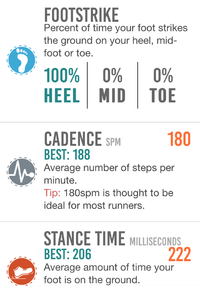 Foot Strike, Cadence and Stance Time (Ground Contact Time) |
4 BSX
The BSX Lactate Threshold Monitor attempts to estimates your Lactate Threshold by measuring the oxygen saturation of the blood within your muscles. The results of the first version were extremely disappointing, but I have not had the opportunity to fully test the updated hardware. However, even if the BSX works perfectly, its value is limited by the relative ineffectiveness of Lactate Threshold Training. You can read about my testing at BSX.
5 Moxy
Moxy uses the same approach as BSX, using infrared light to detect the oxygen saturation of the muscles of blood. Moxy is not as easy to use as the BSX, but it's the data seems to be rather more reliable, though it requires rather more effort to interpret.
6 Sensoria
The Sensoria smart socks] are made of materials that can detect pressure changes under your foot and transmit them back to anklet that communicates with a smart phone via Bluetooth. The anklet also includes accelerometers to enhance the data gathered from the pressure sensors. While these socks are interesting, unlike a true pressure plate that has a matrix of pressure sensors, the socks have just three sensors, one in the heel and two in the forefoot. Error: Could not parse data from Amazon! for a pair of left & right socks, plus one anklet. Note that the socks last for 60 washes and cost $45, which works out to $0.75 per run. That might be cheap to a triathlete, but to most runners that works out pricy. I have a Sensoria anklet on order and I'll report back soon.
(Sensoria also make a tee that shirt includes an embedded Heart Rate monitor strap, you can plug a standard heart rate transmitter module into. They sell a dual Bluetooth/Ant+ transmitter, as well as working with the Polar H7 and some Garmin modules. )
7 TgForce
The TgForce measures just one thing; the peak impact on your lower leg. While this is a far cry from the broad array of data gathered by devices like RunScribe, TgForce may add some particularly valuable insight. Measuring the impact that the foot can be a little misleading as the movement of your ankle can absorb a significant portion of that shock, so knowing how much of the force is transmitted to your lower leg may give a much better insight into injuries. The impact that your lower leg (tibia) receives will be transmitted into your knee, so reducing that stress might be quite helpful. The companion app only runs on iOS devices, not android, which will limit the appeal for some, and unless you buy two devices, it will only measure one leg at a time. Even if you get two devices, it doesn't appear that the app readily supports this approach, unlike RunScribe that does a lot to provide side to side comparisons. That said, I really like to have real-time feedback, something that TgForce provides, either visually for use on a treadmill, or audibly outside. I am planning on testing TgForce in the near future.
8 Lumo Body Tech
Like many other devices, Lumo uses accelerometers to measure body movement, but uniquely (so far) Lumo places the accelerometers at the small of your back. This allows Lumo to not only detect Cadence and Vertical Oscillation, but also breaking and pelvic movement. The measurement of braking force is rather different from RunScribe, as Lumo measures how much your overall body slows up with each stride, rather than measuring the deceleration of your foot in touch down. I believe that both approaches are important, and give valuable insight into possible biomechanical problems. In addition, Lumo will measure how much your hips (pelvis) will drop from side to side, and how much it rotates (twists). Lumo is not yet shipping, but the preliminary price is $80, which is fairly reasonable for this type of device. I really wish that Lumo would measure impact, as it would be great to know how much of the foot strike impact reaches the hips. I am planning on testing the Lumo in the near future.
9 Stryd
Power meters have helped cyclists for a number of years, providing a valuable metric around how hard the cyclist is exercising. Stryd is attempting to provide a power meter for runners, which superficially sounds like a good idea. Certainly, there are many problems with using Heart Rate to determine training intensity, and measuring VO2 is only practical in a laboratory, so and a power meter could be a better option. However Stryd actually measures movement and then calculates power. The details are a little unclear, as their website does not explain their approach or a well, nor do they seem to be any validation studies that I could find. It seems that Stryd measures Vertical Oscillation as the primary metric, along with Ground Contact Time, from a chest strap, so it's a lot like Garmin's Running Dynamics. It seems likely that you could perform similar calculations using the Garmin system, but I find myself unconvinced by the approach.

